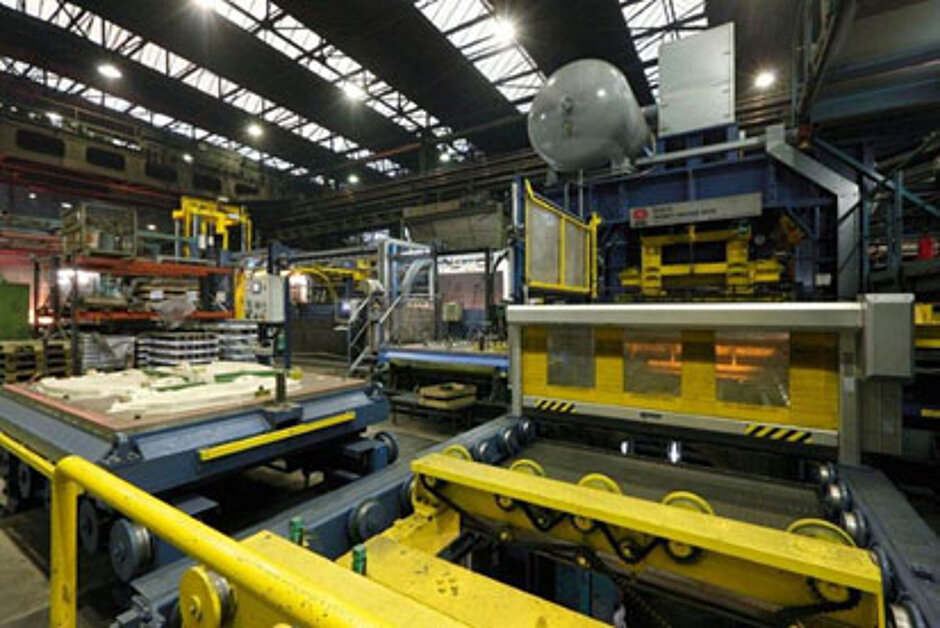Fits like a glove: airflow squeeze technology produces top quality and increases production by 30 percent
The high incidence of reworking and rejects can make the production of casting parts so uneconomical as to be a major hindrance to the success of a business. A major factor in such quality deficiencies is inadequate performance of the moulding plant. If the patterns are not cleanly moulded, the casting parts will also be defective. Every moulding plant manufacturer has developed his own method of turning out moulds with the highest possible precision and maximum repeatability. The iron foundry company Eisengiesserei Baumgarte GmbH decided to deploy the SEIATSU airflow squeeze technology developed by Heinrich Wagner Sinto Maschinenfabrik GmbH (HWS); within only one year, it had increased production by 30 percent, while reducing rejects by 35 percent and downtime by 25 percent. This was achieved without even having to purchase an entire new plant. It was enough to replace the moulding machine and optimise a few other components.
The plant was fully operational after a break in production of only four weeks. The order given by Baumgarte to the HWS machine and plant specialists was very extensive, particularly bearing in mind the time schedule. The task was to remove the previous AIRPRESSplus moulding machine from the existing moulding plant and replace it with a modern HWS SEIATSU moulding machine. In addition, the mould box capacity was enlarged by adding 88 new mould boxes and installing a semi-automatic pattern-changing station. "Our objective was to improve the quality of the casting parts and in turn reduce the amount of subsequent work required," explains Eckhard Winter, CEO of Baumgarte. AIRPRESSplus technology was originally employed for mould compaction. "This was certainly the way to go fifteen years ago, but today the system displays weaknesses in the shape of corners and edges," says Winter.
For this reason, the company decided to replace its moulding machine with SEIATSU airflow squeeze technology. "In principle, the system comprises a two-stage compacting process," explains Michael Exner, Area Sales Manager at HWS. The sand is first weighed into a dosing hopper and then uniformly distributed through vents throughout the mould. A hydraulically controlled disc valve opens a transverse section in a fraction of a second, which allows it to generate the airflow for pre-compaction. In the next stage, the sand is further compacted by a hydraulic multi-ram press. "This method has allowed us to reduce misshaping by 20 percent and the amount of rejects by as much as 35 percent," says Winter, adding that it had also had an impact on production output: whereas 14 moulds per hour had been produced previously, the number had now risen to 20, representing an increase of 30 percent.
New plant components result in less manual intervention and faster production
Additional benefits are also provided by the semi-automatic pattern changing station. It enables an entire pattern assembly to be changed within the cycle time, which means that the plant does not have to stand still, and plant operation can continue unhindered. The machine's semi-automatic design also means that the workplace can be laid out more ergonomically. "It requires less manual intervention and less effort than before", confirms Winter. This represents a further increase in the system's productivity. The incorporation of both a pouring funnel drilling jig and an air-hole punching machine means that many manual work processes are now no longer necessary – while it was previously necessary to punch the air holes into the mould manually, this process is now performed automatically.
Larger product range now possible
Another benefit is that it is now economically viable to produce smaller series. Since it is no longer necessary to halt and refit the plant when changing production over to a new mould series, a series comprising as little as 20 units is also possible. "This increases our product range," says Winter. However, the expanded range was above all down to the enlargement of the mould box. "We have raised the height of the mould box by 50mm so as to increase the range of parts that are possible", explains Winter. The plant is now able to cast large-area and elongated parts with unit weights of 35-800kg. It is also able to overpress by an additional 50mm, permitting the generation of even larger moulds.
HWS machines can also be integrated in third-party systems
It was during the 1980s that HWS implemented the Japanese SEIATSU method in Europe. The process has now established itself worldwide. HWS's modular system enables small and medium-sized companies to optimise their plants, for instance by allowing them to replace or augment individual components only. The HWS moulding machines can be integrated into any existing plant, including those of other manufacturers. "The ability to replace individual plant components represents an effective alternative to purchasing an entire new plant," says Winter, in conclusion.
| Eisengiesserei Baumgarten GmbH was founded in 1932 and is based in Brackwede in Bielefeld. The company's production range comprises pump bodies, washing machine components, bus and railway components, gears, and textile and wood processing machinery. The company generates an annual turnover of 48 million euros and its casting production volume is 28,000 tonnes. The company employs 220 people. Heinrich Wagner Sinto Maschinenfabrik GmbH was founded in 1937 and the Japanese Sintokogio group acquired a majority stake in the company in 1983. As its largest foreign subsidiary, HWS is a market-leading manufacturer of moulding plants and machines, as well as related plant technologies for manufacturing highly compacted moulds for use in modern foundries. The company generates an annual turnover of approximately 75 million euros and employs around 350 people. |
also available in <link record:tt_news:12097 internal-link>![]()
![]()


